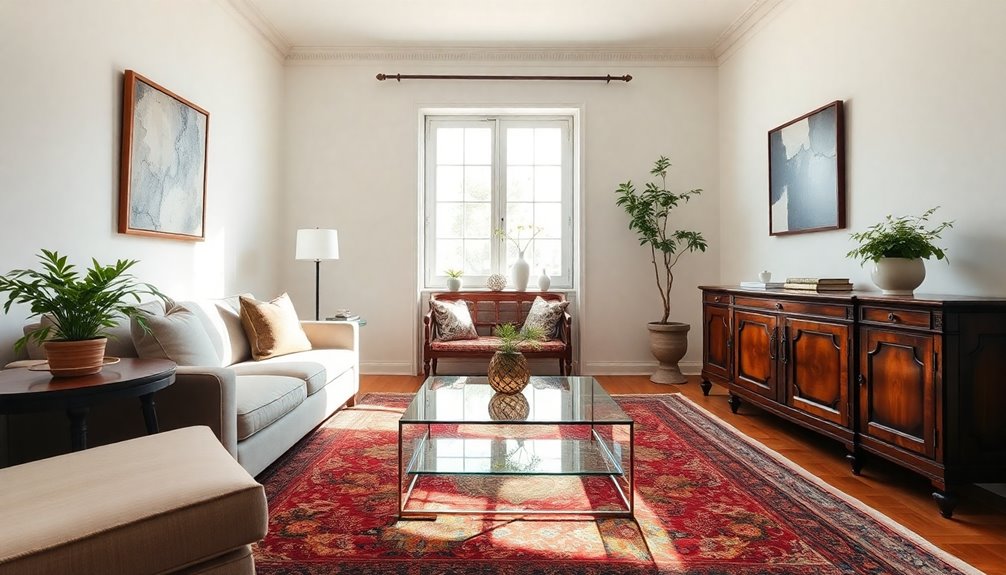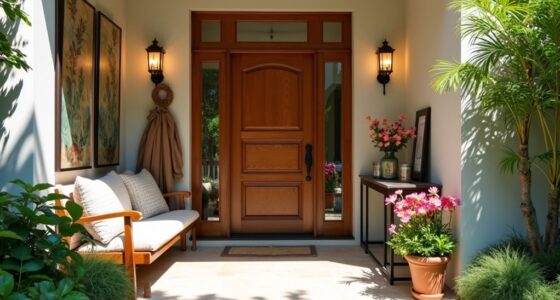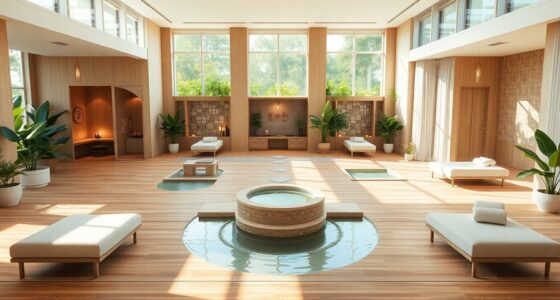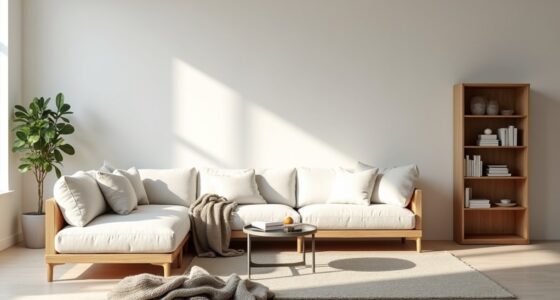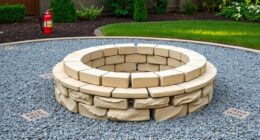Mixing modern and traditional design styles is all about finding the right balance. Start with a neutral backdrop to create cohesion, then layer textures like wood, glass, and metal for depth. Simplify traditional shapes to keep them fresh, and incorporate timeless elements for historical context. Use warm, classic colors to add warmth and interest. Prioritize functionality with multi-purpose furniture and smart technology. Remember, achieving harmony involves mixing contrasting materials and maintaining a consistent color scheme. If you want to explore advanced techniques for successful integration, there's plenty more to discover!
Key Takeaways
- Use neutral colors as a backdrop to create balance between modern and traditional elements.
- Incorporate timeless materials like wood and stone to add warmth to modern designs.
- Layer traditional textiles with contemporary patterns to enhance visual interest and depth.
- Simplify traditional furniture silhouettes for a fresher, modern look while maintaining craftsmanship.
- Ensure a harmonious color scheme to unify contrasting styles and avoid visual clashes.
Understanding Design Fundamentals
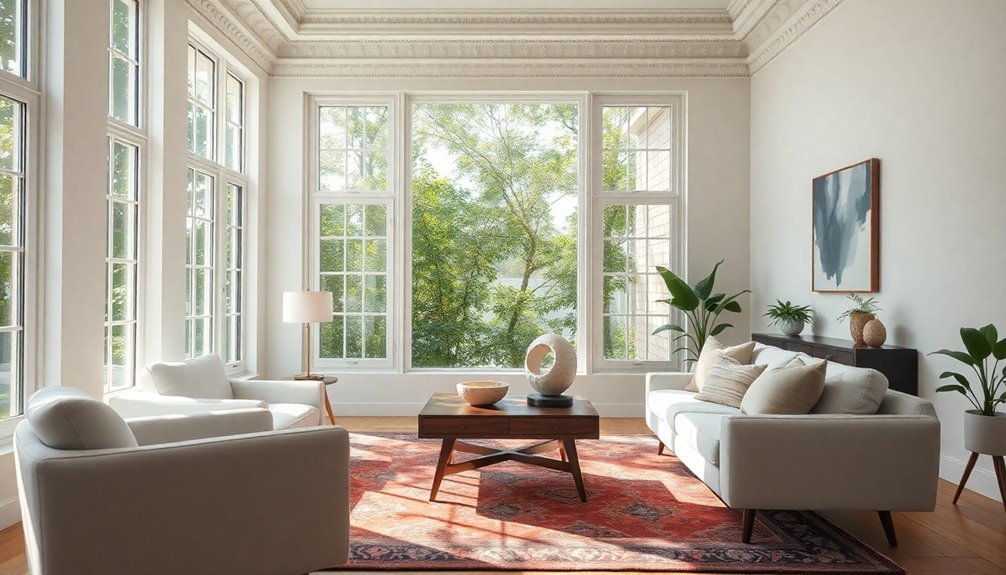
Understanding design fundamentals is crucial for creating harmonious spaces that resonate with both modern and traditional aesthetics.
Start by considering balance; use symmetry for a formal feel or asymmetry for visual interest. Pay attention to the visual weight of elements and utilize negative space to enhance organization.
Proportion and scale matter too; ensure elements relate well in size, following the golden ratio for pleasing aesthetics.
Dive into color theory—understand the color wheel and how warm and cool colors evoke different emotions.
Lastly, incorporate lines, shapes, and textures, guiding the eye and adding depth. Additionally, incorporating natural elements can help create a tranquil atmosphere that complements both styles.
Techniques for Combining Styles

When blending modern and traditional design styles, you can create a stunning aesthetic by employing a variety of techniques.
Start by using neutral colors as a backdrop to balance both styles. Mix textures like wood, metal, and glass to add depth. Look for common ground in design elements, such as clean lines or ornate details, to unify the space.
Layer your elements by starting with a neutral base and incorporating a mix of patterns and artwork. Use lighting that combines traditional chandeliers with modern lamps for a cohesive look.
Finally, prioritize functionality with multi-functional furniture and smart technology, ensuring your space isn't only beautiful but practical. This approach will help you achieve a harmonious blend of styles. Additionally, consider incorporating farmhouse-inspired lighting fixtures to enhance the overall ambiance of your space.
Modernizing Traditional Pieces

Blending modern and traditional design styles often leads to the exciting challenge of modernizing traditional pieces. Start by updating materials; consider incorporating sustainable options like reclaimed wood and bamboo.
Mix innovative textures—pair velvet with metallic accents for a fresh look. You can simplify traditional silhouettes by removing excessive details and using bold colors to rejuvenate the piece. Adding geometric patterns can also give it a modern twist.
Don't forget to preserve traditional craftsmanship; hand-carved details and artisanal techniques maintain authenticity. Incorporating elements like vintage furniture can further enhance the charm of your design.
Finally, balance modern and traditional aesthetics by creating visual flow and using contrasting elements. This approach not only honors the piece's history but also integrates modern sensibilities seamlessly into your space.
Traditionalizing Modern Designs

To create a harmonious space that embraces both modern and traditional designs, you can start by incorporating timeless elements that evoke a sense of history.
Use classic colors like beige, navy, and green to establish a neutral backdrop. Introduce natural materials such as wood, stone, and brick for warmth, while architectural details like columns and moldings lend a traditional touch.
Layer traditional textiles like velvet and linen to add depth. Consider ornate patterns, such as florals and stripes, to enhance visual interest.
Balance these elements with modern functionality by integrating smart technology and ensuring efficient layouts. This approach preserves the charm of tradition while maintaining the sleekness of modern design, resulting in a unique and inviting space. Additionally, incorporating essential elements for a farmhouse dining room can further enhance the overall aesthetic and comfort of the space.
Achieving Balance in Contrasts

Creating a harmonious blend of modern and traditional design styles requires a thoughtful approach to balance contrasting elements.
Start by understanding visual contrasts; use different textures, colors, and patterns to spark interest. Combine functional elements that serve distinct purposes, like sleek modern appliances with ornate traditional furniture.
Balance open spaces with cozy, enclosed areas for spatial contrast. Mix materials, such as wood and glass, to add depth. Use harmonious color schemes to avoid clashes, layering textures for added intrigue.
Ensure both modern and traditional pieces are proportionate in scale, guiding the eye with visual flow.
Finally, incorporate unifying elements like lighting or wall colors to seamlessly tie the space together, achieving a beautiful balance in contrasts. Additionally, consider creating a mood board to visualize the integration of these styles before finalizing your design choices.
Practical Design Applications

While mixing modern and traditional design styles can seem daunting, practical design applications make the process much easier.
Start with space planning by creating multifunctional areas and using modular furniture for flexibility. Divide your space into zones to highlight both design elements, ensuring smooth traffic flow.
When selecting materials, combine textures like wood and glass while opting for durable, sustainable options. Choose a color palette that unifies both styles, and consider various finishing techniques.
For lighting, implement layered designs and utilize a range of light sources to enhance ambiance.
Lastly, select versatile furniture pieces, like a mid-century modern sofa paired with a classic armchair, to create a cohesive yet eclectic look that represents both modern and traditional aesthetics.
Tips for Successful Integration

Mixing modern and traditional design styles can be a rewarding endeavor when you approach it with a clear strategy.
Start by defining each style and identifying key elements like color schemes and architectural features. Set a cohesive vision and gather inspiration from various sources. Create a mood board to visualize your ideas.
Balance the elements by mixing and matching, using neutral colors, and incorporating textiles for warmth.
Select furniture wisely, such as combining a modern sofa with traditional armchairs. Plan the layout to ensure harmony, and use lighting that complements both styles.
Respect original features while adding modern touches, and consider consulting professionals for expert guidance on design aesthetics.
With these tips, you'll create a beautifully integrated space.
Frequently Asked Questions
How Do I Choose a Focal Point in Mixed Design Styles?
To choose a focal point in mixed design styles, start by identifying a striking piece, like a bold sofa or unique artwork.
Consider using contrasting colors to make it stand out. Ensure balance through symmetry or asymmetry, depending on your preference.
Position it thoughtfully for traffic flow and conversation areas, and make sure it aligns with your overall aesthetic.
Cohesive materials and colors will help tie the space together seamlessly.
What Budget Considerations Should I Keep in Mind When Mixing Styles?
You might think mixing styles is just a matter of taste, but your budget tells a different story.
Start by considering your initial investment—modern materials can be pricey while traditional pieces often don't break the bank.
Factor in ongoing maintenance; modern materials require less upkeep than traditional ones.
Also, keep an eye on resale value; modern designs usually attract more buyers.
Ultimately, balancing style and budget is the real art here.
How Can I Ensure My Design Feels Cohesive?
To ensure your design feels cohesive, start by uniting elements like color schemes and materials.
Use a consistent palette and mix textures for depth.
Balance large modern pieces with smaller traditional items, and maintain proportion in your arrangements.
Incorporate natural elements and geometric shapes for common themes.
Strategically place items to create a visual flow, and use neutral backgrounds to let each element shine.
This approach will harmonize your space beautifully.
Are There Specific Color Palettes That Work Best for Mixing Styles?
When mixing styles, certain color palettes can really elevate your space. You might consider neutral palettes for a timeless feel, bold colors for a lively atmosphere, or nature-inspired hues to bring the outdoors in.
Monochromatic schemes can create a harmonious look, while adding depth and interest. Each choice adds character and balance, allowing you to seamlessly blend modern and traditional elements, making your design truly unique and inviting.
How Do I Avoid Clashing Styles in My Space?
To avoid clashing styles in your space, start by identifying common elements.
Use a unifying color palette and mix natural materials like wood and stone.
Balance modern and traditional pieces by considering scale and placement—make sure they complement each other.
Don't forget the 60-30-10 rule for color distribution, and pay attention to details like finishes and accessories.
Experiment with different combinations until you find a harmonious look that feels right for you.
Conclusion
Mixing modern and traditional design styles can transform your space into something truly unique. Did you know that 72% of homeowners believe a well-balanced mix of styles enhances their home's appeal? By understanding the fundamentals and applying the techniques discussed, you can create a harmonious environment that reflects your personality. Remember, it's all about achieving balance and making thoughtful choices. So go ahead, experiment with your designs, and let your creativity shine!
